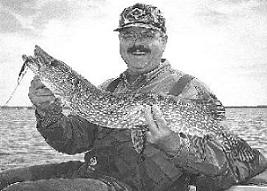Fly-fishing for Prairie Pike, Part 5
Fly-fishin Techniques for Pike
By Clive Schaupmeyer
This the fifth of a series of five articles about fly-fishing
for pike. The articles include: introduction; equipment and rigging; flies
and other gear; when and where; and techniques.
Not a lot to say about technique. Try various retrieval depths, strip
speeds and actions until something works. Here's a good way to start. After
casting your fly, let it sink for a few seconds, depending on water depth,
then retrieve the line in short, snappy four-inch strips every second or
two.

Strip speeds don't have to be fast, but they usually need to be lively.
In spring, sluggish retrieves just don't get pike excited. Or, I should
say that lively strips work well in the spring and I am not about to change
a technique that works.
In midsummer, when water temperatures increase, a more sluggish fly
retrieve may be required. We normally quit fly- fishing for pike in June
when the water gets warmer, but in the summer of 1998, some friends continued
fishing and caught lots of pike in July–and the action carried on well
into August. Local fly-fishing club member, Alan Kloepper, told me that
he had noticed a slower recovery seemed to produce more pike.
On my first late July outing, I let the fly sink down several feet and
used the faster strips–not as Alan had suggested. It worked, but not like
in spring. I then tried keeping my line barely tight and pulled on it very
slowly. There was little forward movement or action to the fly, but it
worked well. One evening using this retrieve, I landed five pike that had
merely mouthed my gaudy streamer–not one of them hit it. I could feel there
was a fish at the fly because of a slight tension, and sometimes the line
vibrated, whereupon I set the hook.
Releasing Pike:
Debarb all pike flies!
Fly-fish for pike with heavy gear that allows you to get a fish to hand
as soon as possible without undue fatigue. Pike can usually remain in the
water while the hook is removed, especially if lip hooked. Sometimes they
will have to be gently lifted out onto the mesh deck of the float tube
or pontoon boat. Handle them carefully, trying not to damage their delicate
gills or remove excessive amounts of mucus from their skin.
Landing nets should not be used for pike that are to be released. They
twist and tangle too much, making them difficult to remove from the webbing.
Many fly anglers use landing cradles (hammocks), which allow large pike
to be gently controlled while the hook is removed.
Most pike are lip hooked and the fly is easily removed, especially if
it is barbless. But, as mentioned, jaw spreaders and long forceps are a
must to remove the occasional streamer that is hooked down inside the mouth.

When the hook has been removed, cradle the fish in the water and move
it gently back and forth until you are certain it can swim away. Usually,
you will be rewarded with a spray of water in the face as the lively pike
splashes its tail to escape, which is fair ball considering what you have
just done to it.
This is the last of a five-part series on fly-fishing for pike.
~ Clive Schaupmeyer
Our Man In Canada Archives
|

 May 10th, 1999
May 10th, 1999



 May 10th, 1999
May 10th, 1999

